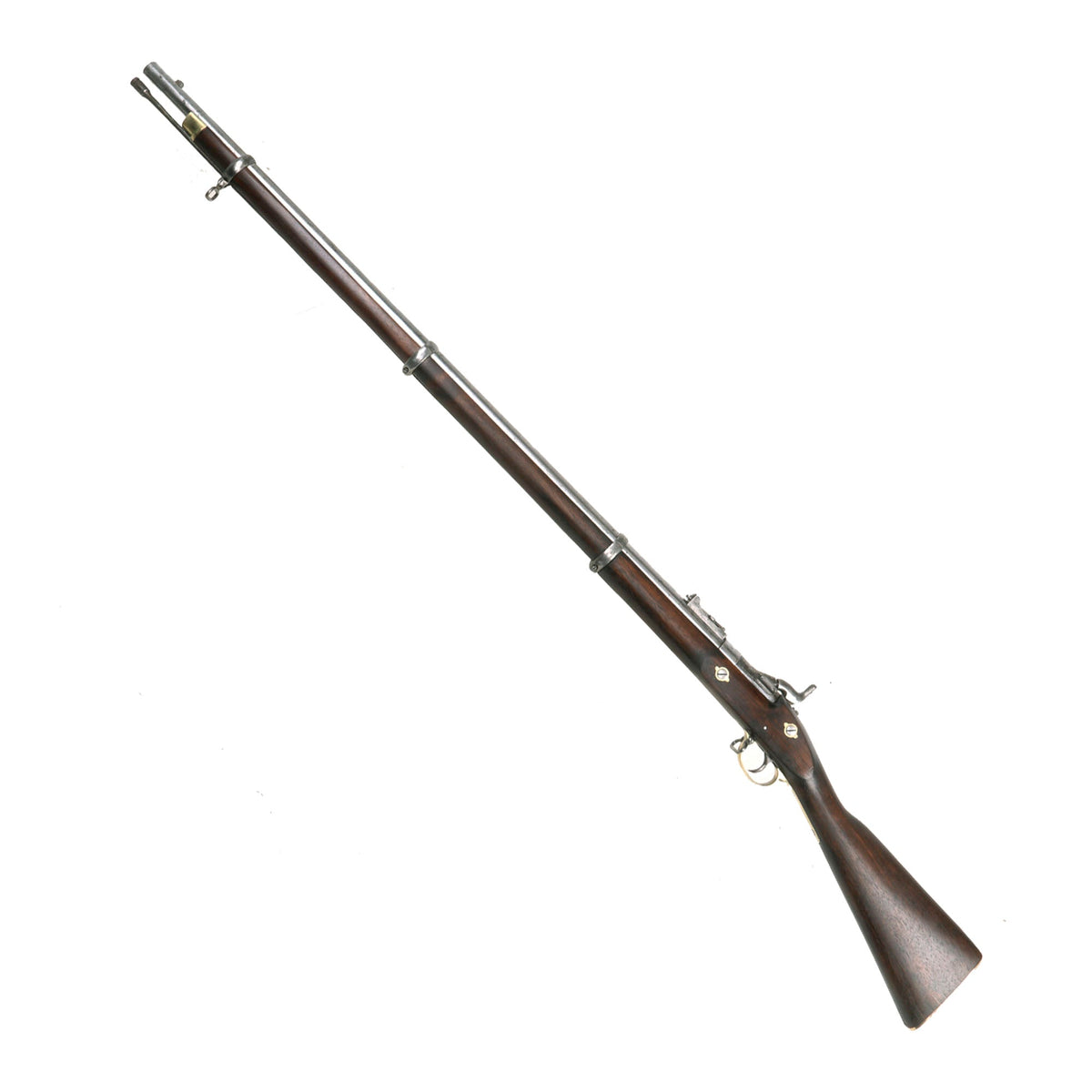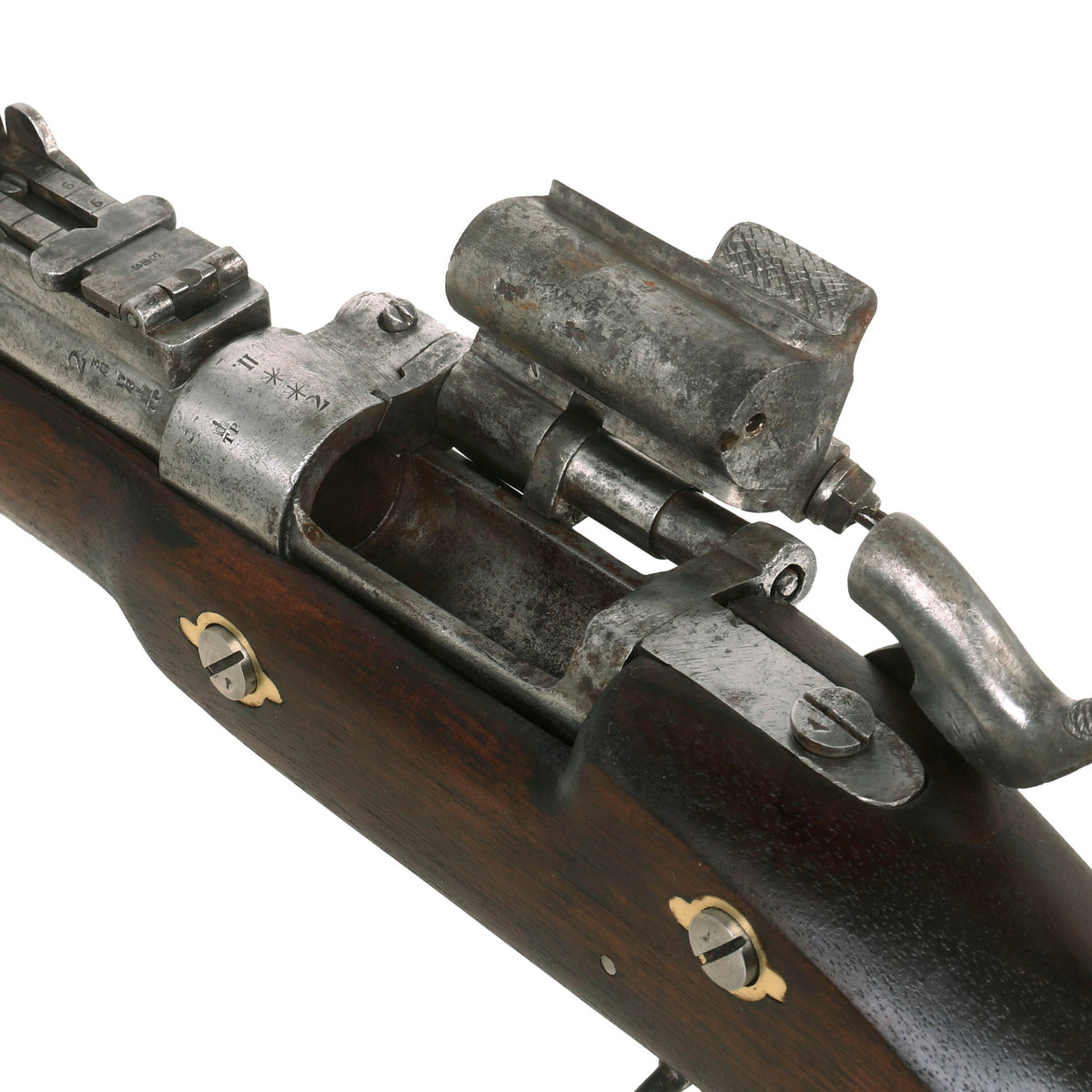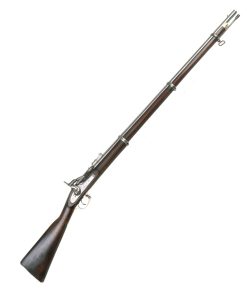Original British P-1853 Enfield Three Band Rifle Converted to Snider Mk.II** dated 1863 – Documented USGI Afghanistan Bring Back Original Items
$ 1.895,00 $ 473,75
Original Item: Only One Available. This rifle is 100% all British manufactured 1863-Dated Three-Band Snider-Enfield rifle, with a fantastic look! This example was purchased directly from a Veteran of the War in Afghanistan, who brought this back in 2016, and comes with a copy of the original bring back documentation. These old rifles had remained there since the colonial wars of the Victorian era, and in many cases were still well cared for. In some cases they were actually still in use! Many similar old British guns were sent back home during the 2000s by both service members as well as civilians involved in the conflict.
This rifle started life in 1863 as a .577 caliber three band ENFIELD Percussion Rifle model of P-1853. The lock is plate stamped “CROWN” over V.R. and ENFIELD / 1863, indicating manufacture at the Royal Small Arms factory at Enfield Lock. This was a military issue, as indicated by the Royal Cypher monogram. It also has the correct CROWN / BROAD ARROW “lock viewer’s” mark and additional proofs as well on the lock plate. The barrel has copious British markings and proof marks, and the whole rifle is in lovely condition.
There are two great Enfield cartouches on the right side of the buttstock. Overall there is a fair amount of rust pitting that has been cleaned. There is the correct II * * stamped on top of the breech ring, indicating it is the MkII** version of the breech. This was the last version before the “latch” was introduced, though it does have a small “button” at the bottom of the breech plug that grips the breech block. The breech block itself is also marked by maker B.S.A.Co, or Birmingham Small Arms Co, and also has the SNIDER PATENT marking surrounding an arrow.
The bottom of the block itself is marked with serial 842 and a proof mark. The barrel still has the original proof marks on the left side under the sight, including a CROWN / TP / 2 “Tower Proof”, 3/13, 17/13, and various Enfield and war department proofs. There are additional proofs on the action, and on many of the other components as well.
The metalwork overall has a lovely polished patina, showing some past oxidation in areas. The top of the barrel and even the receiver tang and side have been covered with the previously mentioned engraving, which has the recessed areas antiqued to give it a better look. The lock still functions at half and full cock, firing at full. The breech unlocks correctly, with an intact firing pin, and can be pulled back to eject spent cartridge casings. The barrel shows three groove rifling, and is in good condition, showing a somewhat bright finish with clear land and grooves, with some light fouling and oxidation in the grooves.
The stock is in lovely condition, and looks to have been reconditioned and varnished long ago. There are some pressure dents, scratches, and other signs of service, but it has a lovely color. Both sling swivels are present, as well as an original cleaning rod. The rear sight is present and fully functional, still bearing western numerals.
This rifle was brought back from Afghanistan by Craig C. Pearson of South Lyon, Michigan. It comes with a copy of the original bringback forms, marking the rifle as an “Enfield Rifle, Year of 1863, Serial number N/A as the rifle itself has no serial. The affidavit is signed August 22nd, 2017.
An All British P-1853 Converted Snider Rifle made at ENFIELD that saw service during the Anglo-Afghan wars, and then stayed behind to be found by a USGI during the 21st century. in splendid condition and ready to display!
Specifications:
Year of Manufacture: 1863 – Converted Later
Caliber: .58 inches
Ammunition Type: .577 Centerfire Cartridge
Barrel Length: 36.5 inches
Overall Length: 55 inches
Action: Side Action Lock
Feed System: Side Hinge Rotating Breech block
More on the P-1853 Rifle-Musket: The Enfield Pattern 1853 rifle-musket (also known as the Pattern 1853 Enfield, P53 Enfield, and Enfield rifle-musket) was a .577 calibre Minié-type muzzle-loading rifle-musket, used by the British Empire from 1853 to 1867, after which many Enfield 1853 rifle-muskets were converted to (and replaced in service by) the cartridge-loaded Snider-Enfield rifle.
The term “rifle-musket” originally referred to muskets with the smooth-bored barrels replaced with rifled barrels. The length of the barrels were unchanged, allowing the weapons to be fired by rank, since a long rifle was necessary to enable the muzzles of the second rank of soldiers to project beyond the faces of the men in front. The weapon would also be sufficiently long when fitted with a bayonet to be effective against cavalry. Such guns manufactured with rifled barrels, muzzle loading, single shot, and utilizing the same firing mechanism, also came to be called rifle-muskets.
The 39 in (99 cm) barrel had three grooves, with a 1:78 rifling twist, and was fastened to the stock with three metal bands, so that the rifle was often called a “three band” model.
History of the Snider rifle– Jacob Snider, an American from New York, developed this breech loading system for the P-1853 Enfield, the most prolific imported Percussion rifle in use by both the North and South during the U.S. Civil War. When the British Board of Ordnance appointed a Select Committee in 1864 the Snider system was swiftly adopted with the first breech loaders being issued in 1865 to British forces.
Improved in 1867 by the use of Colonel Boxer’s center fire brass bodied cartridge, the rifle was used very effectively in the Abyssinian Campaign of 1868. The system utilized a hinged breech block with an internal firing pin assembly that permitted the use of a self contained cartridge of lead bullet in cardboard, and, after 1867, brass casing. This highly efficient conversion system prolonged the active life of the P-1853 rifles up until 1871 when the Martini System was adopted. Snider rifles saw continued use throughout the Empire but were officially obsoleted by the late 1880s.
NOTE: International orders of antique firearms MUST be shipped using UPS WW Services (courier). USPS Priority Mail international will not accept these. International customers should always consult their country’s antique gun laws prior to ordering.
Fast Shipping with Professional Packaging
Thanks to our longstanding association with UPS FedEx DHL, and other major international carriers, we are able to provide a range of shipping options. Our warehouse staff is expertly trained and will wrap your products according to our exact and precise specifications. Prior to shipping, your goods will be thoroughly examined and securely secured. We ship to thousands clients each day across multiple countries. This shows how we're dedicated to be the largest retailer on the internet. Warehouses and distribution centres can be located throughout Europe as well as the USA.
Note: Orders with more than one item will be assigned a processing date depending on the item.
Before shipping before shipping, we'll conduct a thorough inspection of the items you have ordered. Today, the majority of orders will be delivered within 48 hours. The delivery time will be between 3-7 days.
Returns
The stock is dynamic and we cannot completely manage it because multiple stakeholders are involved, including our factory and warehouse. So the actual stock may alter at any time. It's possible that you may not receive your order once the order has been made.
Our policy is valid for a period of 30 days. If you don't receive the product within 30 days, we are not able to issue a refund or an exchange.
You can only return an item if it is unused and in the same state as the day you received it. You must have the item in its original packaging.
Related products
Uncategorized
Uncategorized
Uncategorized
Uncategorized
Uncategorized
Armoured Fighting Vehicles of the World: AFVs of World War One (Hardcover Book) New Made Items
Uncategorized
Uncategorized
Uncategorized
Uncategorized
Uncategorized
Uncategorized
Uncategorized
Uncategorized
Uncategorized
Uncategorized
Uncategorized
Band of Brothers ORIGINAL GERMAN WWII Le. F.H. 18 10.5cm ARTILLERY PIECE Original Items
Uncategorized
Australian WWII Owen MK1 Machine Carbine SMG Custom Fabricated Replica with Sling Original Items
Uncategorized












































































